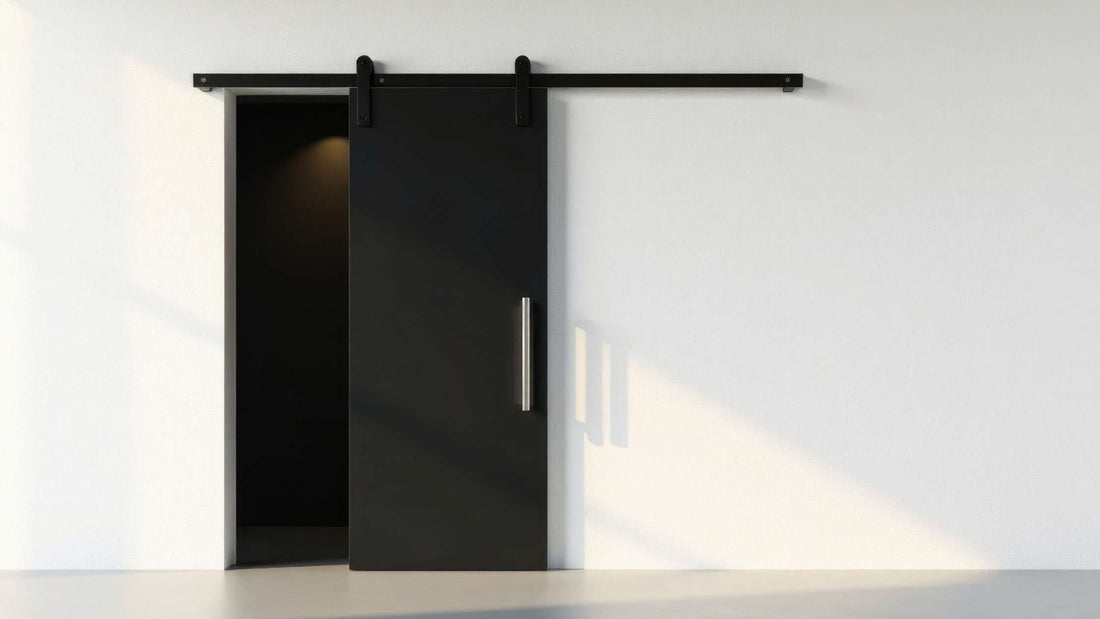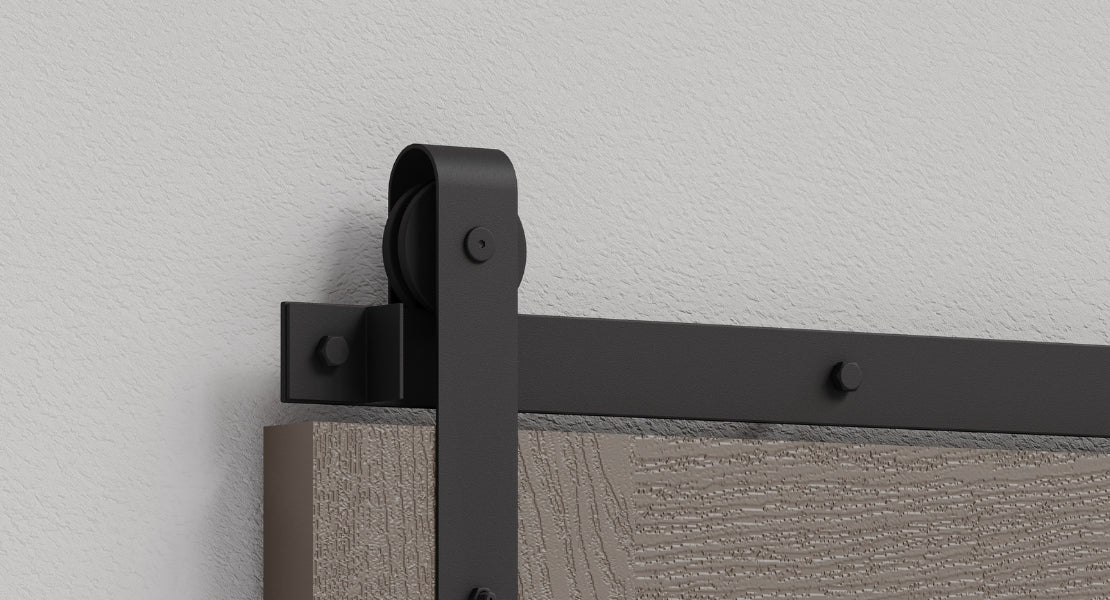
Flat Track vs Box Track vs Tube Track: Which Barn Door Hardware Type is Right for You?
Picture you're standing in the hardware aisle, staring at three different track systems, all claiming to be "the best choice for your barn door."
The flat track kit promises "easy DIY installation." The box track system boasts "commercial-grade durability." The tube track option touts "modern industrial design."
And you're thinking, "Great. Now what?"
Marketing materials show beautiful installations but conveniently skip the technical details that actually matter for your specific project. They don't tell you that your 180-pound reclaimed wood door will destroy that budget flat track system.
Or that installing box track might require professional help and double your budget.
Here's the reality: 80% of installations use flat track, but that doesn't automatically make it right for YOUR door, your wall, or your DIY skill level.
Without the noise, we’re here to guide you through exactly which track type matches your door weight, installation confidence, and design goals.
No guesswork, no expensive mistakes.
What are the Three Track Types for a Barn Door: What You're Actually Choosing Between
Before we dive into which one's right for you, let's get clear on what these systems actually are—and what they're not.
Flat Track: Best for DIY
- What it is: A flat steel rail mounted above your door opening with visible hangers and wheels that roll along the track's surface. The exposed hardware becomes part of your room's design.
- Weight capacity: 200-400 pounds for standard systems, up to 600 pounds for heavy-duty versions
- Best for: Interior doors, DIY installation, farmhouse and industrial aesthetics where you want the hardware to be seen
- Think of it as: The classic barn door look that most people picture—visible track, decorative hangers, and all the rustic charm that comes with exposed hardware.
Box Track: The Heavy-Duty Champion
- What it is: An enclosed U-shaped or rectangular track that completely conceals the rolling mechanism. The trolleys operate inside the track, creating a clean appearance while protecting moving parts.
- Weight capacity: 450-600 pounds standard, up to 5,000 pounds for commercial applications
- Best for: Exterior doors, heavy solid wood doors, commercial applications, anywhere you need serious weight capacity
- Think of it as: The professional-grade solution that prioritizes function over form—stronger, more durable, but less decorative.
Tube Track: The Modern Compromise
- What it is: A round or cylindrical rail with U-shaped hangers that rest above the tube, creating a contemporary industrial look that's cleaner than flat track but more visible than box track.
- Weight capacity: 400-600 pounds typically
- Best for: Modern homes and offices, situations where you want both strength and style
- Think of it as: The newer option that bridges traditional barn door aesthetics with contemporary design sensibilities.
Flat Track Deep Dive: When Simple Actually Works Best
Let's be honest—flat track dominates the residential market for good reasons. It's DIY-friendly, relatively affordable, and gives you that authentic barn door look most people are after.
Why It's the People's Choice
- Installation accessibility: Most homeowners can handle flat track installation with basic tools and a free Saturday. The visible mounting system is forgiving—if something's slightly off, you can usually adjust without starting over.
- Cost effectiveness: Entry points start around $150 for basic systems, with quality mid-range options hitting $200-1000 depending on track length and finish.
- Style variety: Want rustic strap hangers? Sleek modern designs? Decorative horseshoe patterns? Flat track offers the widest selection of visual options because the hardware is meant to be seen.
One customer perfectly captured the appeal: "Have used this hardware for closets or office in two renovations so far. Easy install and beautiful."
The Reality of a Flat Track
But here's what the marketing doesn't emphasize: flat track success depends entirely on three factors most people skip.
- Proper structural support: Those pre-drilled holes? They never align with your wall studs. Ever. You need a solid wood header board spanning the entire track length, mounted securely into studs every 16 inches minimum. Skip this step, and your track will sag within weeks.
- Quality component selection: Plastic rollers may will be more quiet than metal wheels. The difference between a $150 system and a $1000 system is usually in the production quality and weight that the track can support.
- Regular maintenance: Exposed tracks collect dust and debris. Plan on cleaning and lubricating wheels every six months if you want smooth operation.
Flat Track Categories That Actually Matter
- Budget systems ($150-300): Basic carbon steel construction, 150-220 pound capacity, standard black powder coating. Fine for lightweight hollow core doors, but will struggle with solid wood.
- Mid-range systems ($200-700): Upgraded steel construction, ball-bearing rollers, 220-400 pound capacity, multiple finish options. This is the sweet spot for most residential applications.
- Heavy-duty systems ($300+): Commercial-grade components, 400-600 pound capacity, premium finishes, often include soft-close mechanisms. Overkill for most homes, but necessary for massive doors.
Box Track Deep Dive: When You Need Industrial Strength
Box track gets less attention in the DIY world, but there are situations where it's not just better—it's the only safe choice.
Why Choose a Box Track?
- Protected mechanism: Everything that moves is enclosed inside the track. No dust accumulation, no debris interference, no visible wear over time. It's like the difference between an exposed motorcycle chain and a sealed car transmission.
- Superior weight handling: We're talking 450-600 pounds minimum, with commercial systems supporting up to 5,000 pounds. That's not marketing fluff—these systems undergo torture testing exceeding 225,000 feet of travel, equivalent to 30+ years of daily use.
- Weather resistance: The enclosed design makes box track the only viable option for exterior applications. Rain, snow, and wind won't affect the internal mechanism. Not so relevant for interior doors.
When Box Track Becomes Mandatory
- Exterior doors: Period. If your door faces the elements, box track is your only long-term solution. The enclosed design protects against weather while galvanized construction resists corrosion.
- Heavy doors over 400 pounds: That massive reclaimed wood door? Solid oak exterior door? Industrial-style metal door? These need box track's superior weight capacity and load distribution.
- Commercial and high-traffic applications: Schools, offices, restaurants—anywhere doors get heavy daily use benefits from box track's commercial-grade durability and lower maintenance requirements.
The Installation Reality
Here's where the box track gets challenging for DIYers.
Installation requires greater precision than flat track—the complex bracket system demands exact alignment for smooth operation. Plan on 4-8 hours and consider professional installation, especially for heavy-duty systems that might require structural wall reinforcement.
The payoff?
Once properly installed, box track systems can run for decades with minimal maintenance. One commercial installer told me, "I've got box track doors installed 15 years ago that still operate like new. Try that with a budget flat track."
Tube Track Deep Dive: The Contemporary Alternative
Tube track represents the newest evolution in barn door hardware, offering a modern compromise between flat track's decorative appeal and box track's performance.
The Modern Aesthetic Appeal
- Geometric sophistication: The round profile creates clean architectural lines that complement contemporary interiors without the visual weight of traditional flat track systems.
- Self-cleaning advantage: The cylindrical shape doesn't collect dust and debris like flat track surfaces, reducing maintenance while maintaining smooth operation.
- Design bridge: Tube track works in transitional spaces where traditional barn door hardware might feel too rustic, but box track seems too industrial.
Technical Performance
- Construction: Typically 14-gauge steel or aluminum construction providing good strength-to-weight ratios
- Capacity range: 250-600 pounds, depending on the specific system—more than standard flat track but less than heavy-duty box track options
- Installation complexity: Moderate DIY requirements, taking 3-5 hours for most homeowners. More precise than flat track but more forgiving than box track.
Market Position and Applications
Tube track serves specific niches particularly well.
Modern offices appreciate the clean industrial aesthetic without the bulk of box track. Contemporary homes benefit from the sophisticated appearance that doesn't compete with minimalist design elements.
The self-cleaning round profile makes tube tracks particularly attractive for dusty workshops or spaces where maintenance access is limited.
The Weight Capacity Reality Check
This is where most people make expensive mistakes. Your track system must handle not just your door's weight, but dynamic forces during operation, plus a safety margin for long-term reliability.
Calculate Your Actual Requirements
- Solid wood doors: Average 2-3 pounds per square foot before adding hardware. A 36" x 84" solid pine door weighs about 150 pounds before you add handles, locks, or decorative elements.
- Reclaimed wood: Often denser than new lumber—plan on 3-4 pounds per square foot minimum.
- Additional elements: Door handles add 2-5 pounds, decorative hardware adds 3-8 pounds, glass panels can add 6-12 pounds per square foot.
Professional Safety Standards
Choose track capacity rated for 1.5-2 times your door's actual weight. This safety margin accounts for dynamic forces when sliding and provides a buffer against premature failure.
Example: 180-pound door needs 270-360-pound minimum track capacity.
Capacity Guidelines by Door Type
- Hollow core doors (45-60 lbs): Any track type works—choose based on aesthetics and budget
- Standard solid wood (100-200 lbs): Quality flat track sufficient with a proper safety margin
- Heavy solid wood/reclaimed (200-400 lbs): Heavy-duty flat track or standard box track required
- Massive doors (400+ lbs): Box track mandatory—no exceptions for safety
Installation Complexity: What You're Really Signing Up For
The marketing makes everything sound "easy," but let's talk about what these installations actually require.
Flat Track: Most DIY-Friendly
- Time commitment: 2-4 hours for an average homeowner with basic DIY experience
- Skill level: Basic drilling, measuring, and level use. The visible mounting system forgives minor alignment errors.
- Tools needed: Drill, level (preferably laser), stud finder, measuring tape, socket wrench set
- Critical success factor: Solid wood header board installation. This isn't optional for doors over 75 pounds.
Tube Track: Moderate Complexity
- Time commitment: 3-5 hours due to more precise mounting requirements
- Skill level: Intermediate DIY skills needed for accurate alignment
- Challenge: The round profile demands more precise mounting than flat track but proves more forgiving than box track systems
Box Track: Often Professional Territory
- Time commitment: 4-8 hours, often extending to multiple sessions for complex installations
- Skill level: Advanced DIY or professional installation recommended
- Complexity factors: Complex bracket systems, potential structural reinforcement needs, exact alignment requirements for smooth operation
Universal Installation Requirements
Regardless of track type, these factors determine success or failure:
- Structural support: Header boards must use solid wood (never MDF), span entire track length, and secure into studs every 16 inches minimum
- Clearance requirements: Plan for 6.5-7.5 inches from door top to ceiling for proper hardware clearance
- Level installation: Use laser levels rather than trusting existing floors or ceilings as reference points—old houses especially, need independent level verification
Aesthetic Impact: How Track Choice Shapes Your Space
Your track selection doesn't just affect function—it becomes a design element that influences your entire room's character. Well worth thinking about.
Flat Track: Hardware as Decoration
- Design philosophy: Exposed hardware becomes part of the room's visual appeal. Decorative hangers, visible wheels, and track finishes contribute to the overall aesthetic.
- Style compatibility: Perfect for farmhouse, rustic, industrial, and traditional themes where hardware authenticity enhances character
- Customization options: Widest selection of decorative hangers—from simple straps to ornate horseshoe designs, spoke wheels to modern geometric patterns
Box Track: Sophisticated Minimalism
- Design philosophy: Clean, unobtrusive profile lets door panels dominate visual attention. The track recedes into background architecture.
- Style compatibility: Ideal for modern, contemporary, and professional environments requiring refined, understated hardware
- Visual benefit: Creates focus on door materials and finishes rather than hardware mechanics
Tube Track: Contemporary Industrial
- Design philosophy: Geometric round profile creates architectural interest while maintaining cleaner lines than traditional flat track
- Style compatibility: Bridges traditional and modern aesthetics, working well in transitional spaces and contemporary homes with industrial touches
- Unique appeal: Offers industrial character without the visual weight of traditional barn door hardware
Finish Options Across All Types
- Current trends: Matte black dominates, coordinating with diverse design elements while providing timeless appeal
- Contemporary choices: Stainless steel and brushed nickel serve modern applications with clean, reflective finishes
- Traditional warmth: Oil-rubbed bronze and brass provide richness for classic and transitional interiors
- Custom possibilities: Premium manufacturers offer 20-40 finish options, including custom powder coating for perfect design coordination
Making Your Decision: The Selection Framework
Here's how to cut through all the options and land on the right choice for your specific situation.
Step 1: Start With Door Weight
This is non-negotiable. Calculate your door's actual weight, including all hardware, then apply the safety margin.
- Under 150 lbs: Any track type works—choose based on aesthetics, budget, and installation preference.
- 150-300 lbs: Quality flat track or tube track with appropriate capacity ratings
- 150-600 lbs: Heavy-duty flat track or standard box track required
- Over 400 lbs: Box track—no other option provides adequate safety margin
Step 2: Assess Installation Environment
- Interior, climate-controlled: All track types viable
- Exterior, weather-exposed: Box track required for weather protection
- High-dust environments: Box track or tube track preferred for reduced maintenance
- High-traffic commercial: Box track provides superior durability
Step 3: Match Your DIY Comfort Level
- Confident DIYer with basic tools: Flat track is an excellent choice
- Moderate skills, willing to take time: Tube track manageable
- Limited experience or heavy doors: Professional installation recommended, especially for box track
Step 4: Align Aesthetic Goals
- Traditional, rustic, farmhouse: Flat track provides authentic character
- Modern, contemporary, minimalist: Tube track or box track, depending on capacity needs
- Professional, commercial environments: Box track delivers sophistication
The Decision Matrix
- Calculate door weight (including hardware and safety margin)
- Identify installation environment requirements.
- Assess your DIY capabilities honestly
- Define aesthetic priorities for your space
- Set a realistic budget including installation and long-term costs.
- Select track type matching all requirements
Common Decision Scenarios
- Bedroom door, solid wood, DIY installation: Mid-range flat track with ball-bearing rollers
- Bathroom door, privacy important, moderate budget: Quality flat track with soft-close mechanism
- Exterior patio door, heavy construction: Commercial-grade box track with professional installation
- Modern office space, contemporary aesthetic: Tube track with premium finish
- Commercial restaurant, high traffic: Heavy-duty or box track system
Wrapping up
flat track systems operate flawlessly for decades when properly installed, and I've seen premium systems fail within months due to poor mounting.
The non-negotiables:
- Solid structural support: Header boards using solid wood, never MDF. Secure into multiple wall studs with lag bolts.
- Precise level installation: Even slight variations create gravity-induced sliding and premature wear.
- Quality fasteners: Use lag bolts rated for dynamic loads, not basic wood screws.
- Proper clearances: Ensure adequate space for door operation and hardware movement.
- Regular maintenance: Clean tracks, lubricate wheels, check hardware tightness biannually.
Whether you choose DIY-friendly flat track, industrial-strength box track, or contemporary tube track, success lies in matching the right system to your requirements and executing the installation with professional-level precision.
Skip the hardware lottery.
The Barn Door Hardware Store stocks flat tracks with the mounting hardware that actually works—solid wood header boards, dynamic-rated lag bolts, and precision levels included.
Build it once. Build it bulletproof.
Expert installation guidance included—because expensive do-overs suck.




